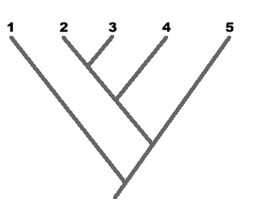When ATP releases some energy, it also releases inorganic phosphate. What happens to the inorganic phosphate in the cell?
A) It is secreted as waste.
B) It is used only to regenerate more ATP.
C) It may be used to form a phosphorylated intermediate.
D) It enters the nucleus and affects gene expression.
C
Biology & Microbiology
You might also like to view...
A ________ is a disease that primarily infects animals but can be transmitted to humans
A) nosocomial infection B) zoonosis C) vector infection D) mudurane
Biology & Microbiology
The human appendix is the equivalent of which of the following structures?
A. the cecum B. the abomasum C. the omasum D. the rumen E. the reticulum
Biology & Microbiology
3 types of study designs
What will be an ideal response?
Biology & Microbiology
 Based on the phylogeny shown, the group of species including (2-5) can best be described as a
Based on the phylogeny shown, the group of species including (2-5) can best be described as a
A. synapomorphy. B. paraphyletic group. C. cladogram. D. polyphyletic group. E. clade.
Biology & Microbiology